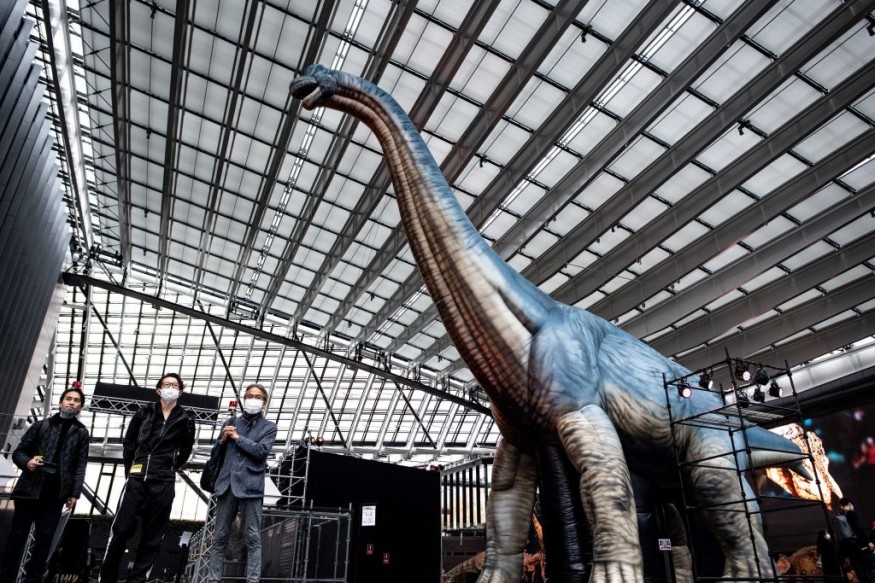Getting hit by a sore throat causes many of us to feel under the weather, but recent discovery shows that just like us, dinosaurs were struck down with colds as well. Scientists add that the Brontosaurus-like dinosaurs were more than likely experiencing similar symptoms to humans. This includes trouble breathing, coughing, and fever. Additionally, scientists speculate that these sickness-stricken reptiles felt just as miserable as humans when sick.
Evidence of Dinosaur Cold Unearthed in Montana

Initially discovered in 1990, a Diplodocid specimen dubbed 'Dolly' was unearthed in Montana and dated back to roughly 150 million years ago, placing it around the Late Jurassic Period.
In the study published in the journal Scientific Reports, titled "The first occurrence of an avian-style respiratory infection in a non-avian dinosaur," Cary Woodruff and her team from the Great Plains Dinosaur Museum, Montana, analyzed three of Dolly's neck bones and was able to identify the first-ever evidence of abnormal bony protrusions that had both an unusual texture and shape.
The said protrusions were observed in the bone regions likely attached to air-filled structures, also known as air sacs. These sacs connected to the reptile's lungs form part of the Diplodocids respiratory system.
CT scans of Dolly's irregular protrusions showed that they were made of abnormal bone that was most likely formed due to an infection. Based on the location of the protrusions, researchers hypothesize that the abnormal bony protrusions were a response to infection in Dolly's air sacs that later may have spread to its neck bones.
Likewise, scientists theorize that Dolly's predicament could have been caused by a fungal infection like aspergillosis, a common respiratory illness affecting many reptiles and birds, leading to a bone infection in severe cases.
If Dolly was indeed infected with aspergillosis, researchers explain that the dinosaur would have experienced pneumonia or flu-like symptoms like coughing, weight loss, breathing difficulties, and fever. Also, since aspergillosis can be fatal for avian species if left untreated, scientists believe it is a probable explanation for Dolly's demise.
Woodruff explains that given the possible symptoms Dolly suffered from, holding the infected fossils in their hands, researchers couldn't help but feel sorry for the unlucky dinosaur that got infected with a cold.
She adds that humans experience similar symptoms all the time now a 150-year-old dinosaur may have felt just as miserable as the rest of us when we're sick.
In addition to the documentation of the first-ever occurrence of this type of respiratory infection in dinosaurs, authors of the study say that the discovery also has significant anatomical implications for the sauropod dinosaurs' respiratory system.
Woodruff explains that the fossils infection in Dolly helped researchers trace the evolutionary history of respiratory-related illnesses in time and gave them a deeper understanding of what diseases plagued dinosaurs, reports DailyMail.
ALSO READ : Devon Cave Unearthed with Remains of Megafaunas and Other Ice Age Species From 60,000 Years Ago
Understanding Dolly: The Sick Diplodocid
Diplodocids include some of the longest species to walk the planet, belonging to a distinct group of sauropod dinosaurs. Some members of the large, long-necked reptiles that included Supersaurus and Diplodocus reached up to 112 feet long. Although these reptiles have long necks, their legs were not.
Scientists wrote in the study that if continued investigations ensue, we will be able to continuously document and trace the medical conditions present today and better our understanding of the illnesses that affected the dinosaurs and how the identification of the said disorders can contribute to our understanding of the physiology of dinosaurs.
RELATED ARTICLE: Fossils of New Titanosaur Species Twice the Size of Bus, Weigh 28 Large Grand Pianos Unearthed in Spain
Check out more news and information on Paleontology in Science Times.
© 2025 ScienceTimes.com All rights reserved. Do not reproduce without permission. The window to the world of Science Times.












